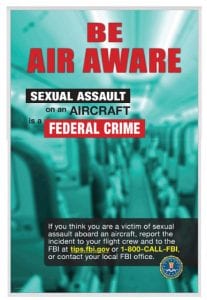The FBI has reported that unwanted advances are “on the rise” on airlines. I have 12 tips for women to help them avoid sexual assaults while flying.

According to the DOJ, the woman stated that the man “reached under her arm to touch her breast.” She said he did it three times. The DOJ also said that a preliminary FBI investigation revealed that this was not the first time. The defendant was alleged to have acted in an inappropriate and harassing manner. There have been two other allegations.
American Airlines announced that the man has been banned from flying on American.
The FBI states that in recent years, in-flight sexual assaults are on the rise.
In recent years, sexual assault on airplanes has risen. Last year, the FBI released a report that stated that in 2023, the FBI opened 96 cases of in-flight sexual assault. The full statistics are not yet available for 2024, though overall, unruly passenger incidents reported by the FAA rose slightly in 2024 compared to 2023. They include sexual assault cases.
It’s unfortunate that this needs to be said in the 21st century. Women are not the problem, not at fault in any way for being sexually assaulted. Female airline passengers shouldn’t need to take precautions or actions to prevent these crimes. Women have done nothing to deserve these attacks, but they do occur.
Sexually assaulted women unfairly must deal with shame and blame based on the false claim that the assaults are at least partly their fault. We need to support women and help them prevent such attacks.

Women and experts with whom I’ve spoken tell me that the long history in human society of shaming and blaming women for being sexually attacked is still alive. Too many people believe that when a woman is sexually assaulted, that somehow it’s their fault. Women who were assaulted are told that it’s the way they dressed, their perfume, their make-up and their body language, no matter how off-putting, are somehow the cause of the attack. Unfortunately, that holds women back from being willing to disclose assaults to anyone, friends, family and third parties, such as flight attendants and law enforcement. Prompt reporting to a flight attendant, while in-flight, to stop an attack is essential. Then to hopefully prevent an attack on another person, speaking to law enforcement is critical.
Overcome Social Pressure:
There is significant social pressure on women who are sexual attack victims to keep quiet. It’s hard to overcome the pressure, particularly when it comes from family who are worried about embarrassment, but if nothing else, women who are victims of sexual attacks while in-flight should remember that speaking up can prevent others from also becoming victims.
Dress conservatively, use effective body language, listen to music, watch movies, read books, and play games. Wearing sunglasses can help women send a message to passengers engaging in unwanted contact.
Dress conservatively:
While women should be able to wear whatever they desire when they fly, within the bounds of their airline’s rules, it’s best to dress on the conservative side to send a clear message to other passengers, particularly men. Women should let their clothes tell other passengers that they’re not looking for romance, that they’re serious people just trying to get to their destination.
Body language can set a physical boundary:
Psychologists tell us that most people are at least subconsciously attuned to the body language of others. If you’re getting unwanted attention or advances, use body language to hopefully shut them down. Turn physically away from the passenger. Fold your arms. Look away from them. Stare out the window or down the aisle. Also turn your feet away from them.
Use headphones:
Unwanted conversation can lead to an eventual assault. In and of itself, it also can make a flight tedious and painful. Over the years, I’ve found that putting on headphones and turning away to a tablet to watch a video, listen to music or read a book drives home the message, “I’m not interested.”
Use movies, books and games:
Directing your attention to watching movies, reading a book or playing games immediately tells the passenger making unwanted conversation or advances that you’re not interested in them, though some may ignore the message.
Wear sunglasses:
You can use sunglasses, the darker and larger the better, to prevent accidental eye contact which could be considered an invitation to conversation and potentially more, with another passenger. When my wife has traveled alone, wearing sunglasses on her flights was her normal practice.
Be polite and courteous while being firm to send a clear message to back off to difficult passengers making unwanted advances.
You don’t need to be nice, but you should be polite, courteous and firm:
While some experts say that kindness can help deal with difficult passengers on flights, the experience of many women with whom I’ve spoken is that if they’re nice while stating, “Back off,” it sends a conflicting message. You need to be clear that you want no interaction with them whatsoever. On the other hand, while they may ignore your message, being polite and courteous, plus firm, gets difficult passengers to listen and usually not misunderstand what you’re telling them.
Use a lavatory break:
If you’re getting unwanted conversation and attention from another passenger, but it hasn’t gotten past talk, you should consider taking a lavatory break to halt contact with the passenger. When you get back, try ignoring the passenger and use body language, headphones, sunglasses, etc., to send a message to leave you alone.
 If unwanted physical contact from another passenger occurs, get flight crew help immediately. Strongly request you be moved to another seat.
If unwanted physical contact from another passenger occurs, get flight crew help immediately. Strongly request you be moved to another seat.
Once physical contact occurs, get flight crew help:
If there’s any unwanted physical contact from another passenger, get flight crew help immediately. While you might consider a single touch an accident, it’s hard to believe a second touch is still accidental. If it happens, don’t hesitate for even a nanosecond to get help from the flight crew.
Don’t hesitate to ask to change seats, even on a flight that looks full:
If it were me, without hesitation, I’d firmly ask a flight attendant to change seats immediately after a second unwanted touch from a passenger. It’s the most direct and the surest way to prevent further unwelcome and undesirable contact from a passenger. There are few flights that have no empty seats whatsoever. Statistics show that the average passenger load for flights in the U.S. in 2024 was less than 83 percent.
When reporting your unwanted advances with another passenger, remain calm, be accurate, and include details in your report.
Stay calm, be accurate and detailed:
When you talk with a flight attendant explaining the problem — or later, law enforcement — stay calm. Be accurate and include as many details of your unwanted encounter as possible. That will boost confidence in the veracity of your statement.
Unwanted advances, sexual abuse, assault, or misconduct are not the victim’s fault. Every passenger deserves to fly safely. These tips can help you shut down their bad behavior before it escalates. Don’t accept another passenger’s lousy behavior. If touching or worse occurs, follow my other tips to get help before the other passenger can make you a crime victim.
READ ALSO:
Flight Delay Compensation Rule is DOA
How to save big money with European low-cost airlines
After many years working in corporate America as a chemical engineer, executive and eventually CFO of a multinational manufacturer, Ned founded a tech consulting company and later restarted NSL Photography, his photography business. Before entering the corporate world, Ned worked as a Public Health Engineer for the Philadelphia Department of Public Health. As a well known corporate, travel and wildlife photographer, Ned travels the world writing about travel and photography, as well as running photography workshops, seminars and photowalks. Visit Ned’s Photography Blog and Galleries.




